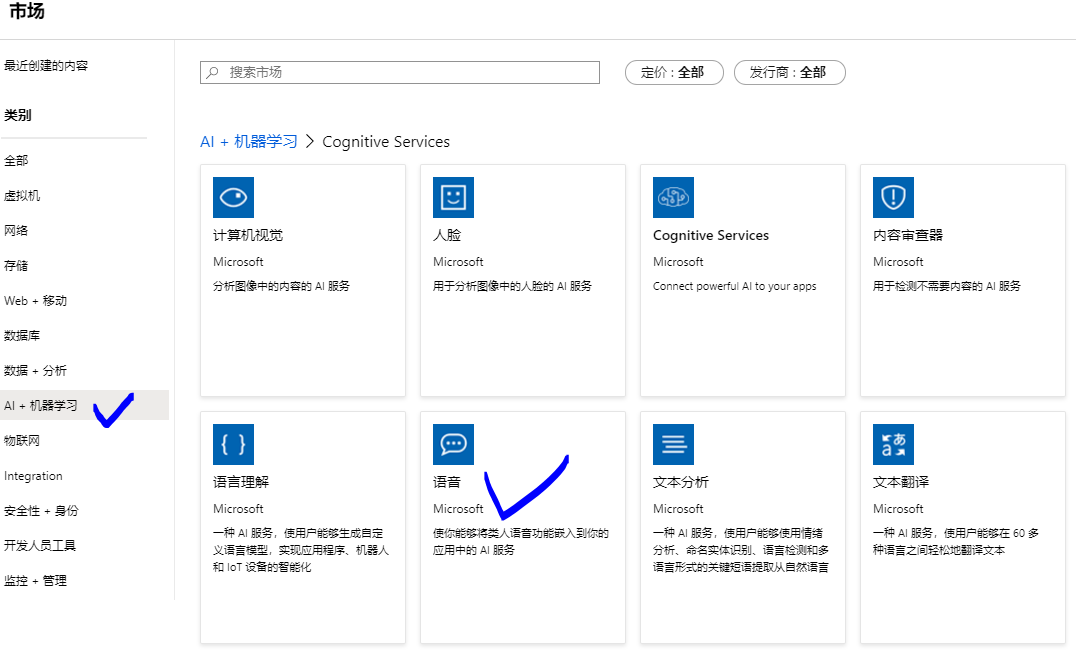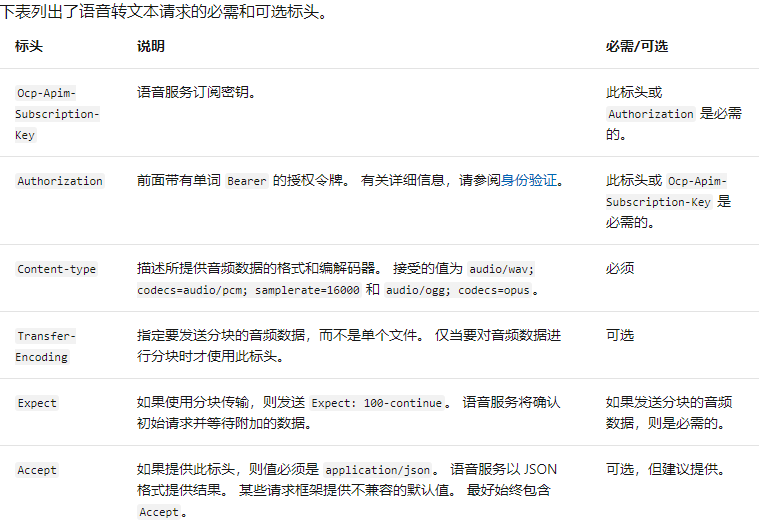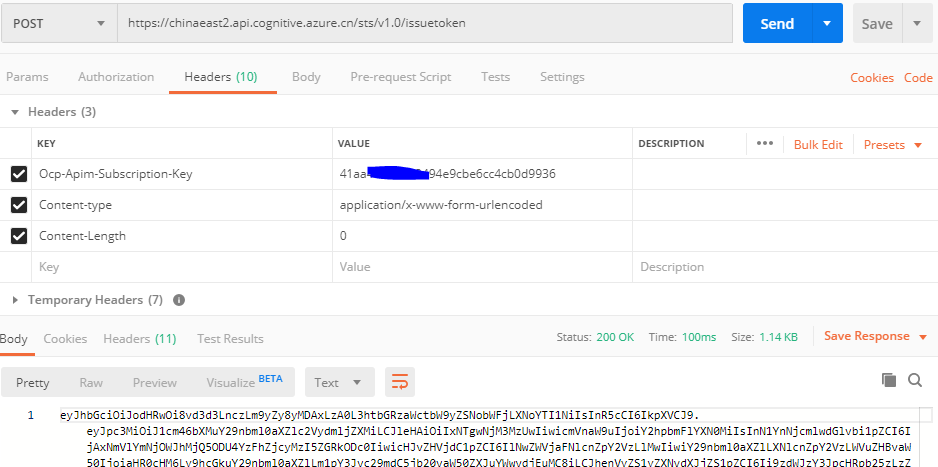
Speech 服务是认知服务的一种,提供了语音转文本,文本转语音, 语音翻译等,今天我们实战的是语音转文本(Speech To Text)。
STT支持两种访问方式,1.是SDK,2.是REST API。
其中:
SDK方式支持 识别麦克风的语音流 和 语音文件;
REST API方式仅支持语音文件;
准备工作:创建 认知服务之Speech服务:

创建完成后,两个重要的参数可以在页面查看:
一. REST API方式将语音文件转换成文本:
Azure global的 Speech API 终结点请参考:
https://docs.microsoft.com/zh-cn/azure/cognitive-services/speech-service/rest-speech-to-text#regions-and-endpoints
Azure 中国区 的 Speech API 终结点:
截至到2020.2月,仅中国东部2区域已开通Speech服务,服务终结点为:
https://chinaeast2.stt.speech.azure.cn/speech/recognition/conversation/cognitiveservices/v1
对于Speech To Text来说,有两种身份验证方式:
其中Authorization Token有效期为10分钟。
为了简便,本文使用了Ocp-Apim-Subscription-Key的方式。
注意:如果要实现文本转语音,按照上表,则必须使用 Authorization Token形式进行身份验证。
构建请求的其他注意事项:
- 文件格式:

- 请求头:

需要注意的是,Key或者Authorization是二选一的关系。
- 请求参数:

在Postman中的示例如下:



如果要在REST API中使用 Authorization Token,则需要先获得Token:
Global 获取Token的终结点:
https://docs.microsoft.com/zh-cn/azure/cognitive-services/speech-service/rest-speech-to-text#authentication
中国区获取Token的终结点:
截至2020.02,只有中国东部2有Speech服务,其Token终结点为:
https://chinaeast2.api.cognitive.azure.cn/sts/v1.0/issuetoken
Postman获取Token 参考如下:
二. SDK方式将语音文件转换成文本(Python示例):
在官网可以看到类似的代码,但需要注意的是,该代码仅在Azure Global的Speech服务中正常工作,针对中国区,需要做特定的修改(见下文)。
import azure.cognitiveservices.speech as speechsdk# Creates an instance of a speech config with specified subscription key and service region.# Replace with your own subscription key and service region (e.g., "chinaeast2").speech_key, service_region = "YourSubscriptionKey", "YourServiceRegion"speech_config = speechsdk.SpeechConfig(subscription=speech_key, region=service_region)# Creates an audio configuration that points to an audio file.# Replace with your own audio filename.audio_filename = "whatstheweatherlike.wav"audio_input = speechsdk.AudioConfig(filename=audio_filename)# Creates a recognizer with the given settingsspeech_recognizer = speechsdk.SpeechRecognizer(speech_config=speech_config, audio_config=audio_input)print("Recognizing first result...")# Starts speech recognition, and returns after a single utterance is recognized. The end of a# single utterance is determined by listening for silence at the end or until a maximum of 15# seconds of audio is processed. The task returns the recognition text as result.# Note: Since recognize_once() returns only a single utterance, it is suitable only for single# shot recognition like command or query.# For long-running multi-utterance recognition, use start_continuous_recognition() instead.result = speech_recognizer.recognize_once()# Checks result.if result.reason == speechsdk.ResultReason.RecognizedSpeech:print("Recognized: {}".format(result.text))elif result.reason == speechsdk.ResultReason.NoMatch:print("No speech could be recognized: {}".format(result.no_match_details))elif result.reason == speechsdk.ResultReason.Canceled:cancellation_details = result.cancellation_detailsprint("Speech Recognition canceled: {}".format(cancellation_details.reason))if cancellation_details.reason == speechsdk.CancellationReason.Error:print("Error details: {}".format(cancellation_details.error_details))
针对中国区,需要使用自定义终结点的方式,才能正常使用SDK:
speech_key, service_region = "Your Key", "chinaeast2"template = "wss://{}.stt.speech.azure.cn/speech/recognition" \"/conversation/cognitiveservices/v1?initialSilenceTimeoutMs={:d}&language=zh-CN"speech_config = speechsdk.SpeechConfig(subscription=speech_key,endpoint=template.format(service_region, int(initial_silence_timeout_ms)))
中国区完整代码为:
#!/usr/bin/env python# coding: utf-8# Copyright (c) Microsoft. All rights reserved.# Licensed under the MIT license. See LICENSE.md file in the project root for full license information."""Speech recognition samples for the Microsoft Cognitive Services Speech SDK"""import timeimport wavetry:import azure.cognitiveservices.speech as speechsdkexcept ImportError:print("""Importing the Speech SDK for Python failed.Refer tohttps://docs.microsoft.com/azure/cognitive-services/speech-service/quickstart-python forinstallation instructions.""")import syssys.exit(1)# Set up the subscription info for the Speech Service:# Replace with your own subscription key and service region (e.g., "westus").speech_key, service_region = "your key", "chinaeast2"# Specify the path to an audio file containing speech (mono WAV / PCM with a sampling rate of 16# kHz).filename = "D:\FFOutput\speechtotext.wav"def speech_recognize_once_from_file_with_custom_endpoint_parameters():"""performs one-shot speech recognition with input from an audio file, specifying anendpoint with custom parameters"""initial_silence_timeout_ms = 15 * 1e3template = "wss://{}.stt.speech.azure.cn/speech/recognition/conversation/cognitiveservices/v1?initialSilenceTimeoutMs={:d}&language=zh-CN"speech_config = speechsdk.SpeechConfig(subscription=speech_key,endpoint=template.format(service_region, int(initial_silence_timeout_ms)))print("Using endpoint", speech_config.get_property(speechsdk.PropertyId.SpeechServiceConnection_Endpoint))audio_config = speechsdk.audio.AudioConfig(filename=filename)# Creates a speech recognizer using a file as audio input.# The default language is "en-us".speech_recognizer = speechsdk.SpeechRecognizer(speech_config=speech_config, audio_config=audio_config)result = speech_recognizer.recognize_once()# Check the resultif result.reason == speechsdk.ResultReason.RecognizedSpeech:print("Recognized: {}".format(result.text))elif result.reason == speechsdk.ResultReason.NoMatch:print("No speech could be recognized: {}".format(result.no_match_details))elif result.reason == speechsdk.ResultReason.Canceled:cancellation_details = result.cancellation_detailsprint("Speech Recognition canceled: {}".format(cancellation_details.reason))if cancellation_details.reason == speechsdk.CancellationReason.Error:print("Error details: {}".format(cancellation_details.error_details))speech_recognize_once_from_file_with_custom_endpoint_parameters()
需要注意的是,如果我们使用SDK识别麦克风中的语音,则将
speech_recognizer = speechsdk.SpeechRecognizer(speech_config=speech_config, audio_config=audio_config)
修改为如下即可(去掉audio_config参数):
speech_recognizer = speechsdk.SpeechRecognizer(speech_config=speech_config)

